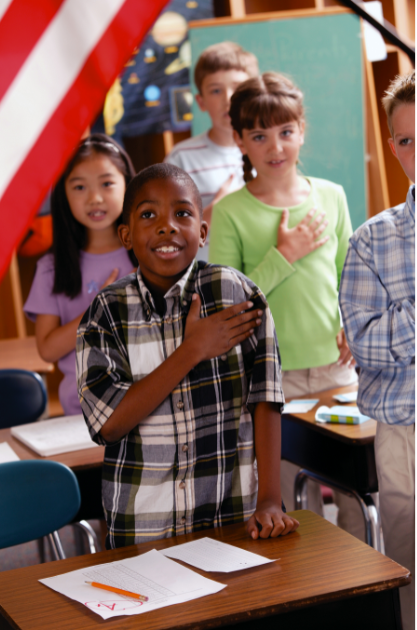The shootings that interrupted an otherwise peaceful protest in Dallas on July 7, 2016, were terrible.
They were also a statistical anomaly and not evidence of a pattern of wider violence. I'll explain that in a moment.
First, here are three images that can help us understand how to process our feelings about this truly awful event. They represent three different, contrasting realities that currently exist in the U.S.:
1. Here's a photo that was taken in Dallas on that same night, before things took a tragic turn:
This photo represents an ideal situation — and in fact, it's a pretty accurate representation of the celebrated work done by the Dallas Police Department in community policing.
If police are public servants who are meant to uphold our rights as citizens, then it is right that they would stand in solidarity with those exercising their First Amendment rights to protest against injustice.
I like to think that the moment reflected here is an accurate representation of the majority of police officers.
These are our brothers and sisters and neighbors and friends, people who willingly enter into a career where they're more likely to encounter a hostile situation than, say, a writer like me. But a lot of their work is doing exactly what you see them doing in this photo.
2. That's the reality of America. But so is this:
American police are also responsible for killing around 1,000 people each year in the United States. Tragically, a disproportionate number of those people are black Americans — 24% per a Washington Post calculation, despite the fact that black Americans comprise only 13% of the U.S. population.
By contrast, the number of police officers killed in the line of duty is much lower and has notably decreased over time. 51 of the 96 police officers who died in the line of duty in 2014 were killed during felonious acts, according to the FBI — killed through the actions of another person, rather than as a result of an accident. 71% of the offenders responsible for those murders were white, despite white people making up 64% of the U.S. population today.
None of this means that officers, particularly those who give their lives in the line of duty, aren't brave and noble individuals worthy of appreciation, of course. But it does mean that it's more likely for a bartender or garbage collector to be killed on the job than it is for a black man to shoot and kill a police officer.
So despite the general high-stakes job, there's no logical reason for police to feel particularly threatened by or anxious around black Americans, despite this shooting.
And yet, this photo still represents the tragic reality that black Americans are forced to live with every day. Regardless of your feelings toward police, I hope you can empathize with the fear that black Americans have during encounters with police — because it is statistically justified. Black Americans are 2.5 times more likely than white Americans to be killed by police, even though white Americans are more likely to kill cops.
This is unfortunate, but it's the truth.
3. We've seen one reality where cops are good but shouldn't feel overly threatened by black people. We've seen another where black Americans are justified in fearing the police. And then there's this:
Screenshot via Twitter.
This tweet was made by a former U.S. congressman from Illinois in the aftermath of the shooting in Dallas. It has since been deleted, although he still stands by the sentiment.
This tweet is indicative of the source of most of the controversy about violence — about whose lives matter and about when those lives can matter. This tweet is the insidious virus of white supremacy laid bare for all to see by a white man in a position of power and influence. It is proof that white supremacy still exists today.
And unfortunately, it is not a statistical anomaly.
It is people like this who create a system that continues to disadvantage black Americans 150 years after the formal end of slavery.
Their actions and influence lead to poverty, which leads to desperation, which leads to racial profiling, which leads to more black Americans in jail, which makes it harder for black Americans to get jobs, which leads to more poverty, desperation, and other problems.
It is people like this who use their power to appeal to the most rotten fears in the hearts of other Americans by pointing to statistical anomalies like a sniper at a Black Lives Matter protest and using that anomaly as evidence or justification of some greater evil while ignoring all other persistent evidence to the contrary.
It is these same people who will readily classify any white shooter as a "lone wolf" or as "mentally ill" — perpetuating the idea that only white people are allowed to be individuals while all minorities must stand as representatives for their entire group. They are the same people who dig up dirt on murdered black Americans while reminiscing about white mass murderers as quiet, gentle men.
You're not going to be able to end poverty or racism or white supremacy all on your own, which is why the events of the past week can feel difficult.
"Fixing this" can feel overwhelming, and it isn't realistic.
But it's also not realistic to "choose a side," to pit police against black Americans. If we do that, we're letting that specter of white supremacy continue to divide our country.
What we can do is speak out against the injustices we see.
If we do that, maybe we can finally start to mend this broken system.
When someone says something racist or does something oppressive or harmful, we can call them on it. Maybe they didn't mean it; maybe they didn't realize they were saying something that perpetuates the roots of white supremacy. But they're not going to learn unless someone takes the time to explain it.
It's also important to listen to people who have other opinions. A lot of people are hurting right now, and with good reason. You don't even have to agree with them to accept that their pain is justified and their perspectives and experiences are real. Reach out and connect, and try to understand someone else's point of view before forcing them to see it from yours.
And you can volunteer. You can tell your friends. You can amplify the voices of the people who are hurting and try to empathize with everyone you meet. You can get mad and use that energy productively instead of sitting back while these things happen again and again and again because you don't think it affects your life. (It does.)
It is 2016 in the United States of America, and these three photos represent three very different realities that still manage to exist at the same time.
And that, in itself, is a problem worth solving.




 American portion sizes are colossal.
American portion sizes are colossal. Tax shouldn't be a not-so-fun surprise at the end of your shopping trip.
Tax shouldn't be a not-so-fun surprise at the end of your shopping trip.  A trip to the doctor shouldn't break the bank.
A trip to the doctor shouldn't break the bank. This totally isn't weird at all. Right?
This totally isn't weird at all. Right? It's a choice.
It's a choice.  America loves extra sugar in savory foods.
America loves extra sugar in savory foods.
 Princess Odette Girl GIF by The Swan Princess
Princess Odette Girl GIF by The Swan Princess  Rose GIF
Rose GIF  sailor moon GIF
sailor moon GIF  river phoenix 80s GIF
river phoenix 80s GIF 
 All of this will be ours one day. Yay.
All of this will be ours one day. Yay.  Elderly woman with white hair on phone, sharing a story about a dead person her child has never met.
Elderly woman with white hair on phone, sharing a story about a dead person her child has never met.  Surprised elderly man in blue shirt against a yellow background.
Surprised elderly man in blue shirt against a yellow background. Elderly woman in pink shirt using a smartphone on a garden swing.
Elderly woman in pink shirt using a smartphone on a garden swing. TV for waking. TV for sleep.
TV for waking. TV for sleep.  Elderly man using a magnifying glass to read a piece of mail
Elderly man using a magnifying glass to read a piece of mail
Mom is totally humiliated after her kindergartner tells the teacher what she does for work
She was clearly mortified.
A mom is embarrassed by her child.
One of the great joys and stresses of parenting is that you never know what will come out of your child’s mouth. When you have young, inquisitive kids, they can say really inappropriate things to people without realizing they were being rude or possibly offensive. TikTok influencer Aurora McCausland (@auroramccausland), known for her DIY cleaning tips, recently told a funny story on the platform about how her son believes she makes a living. The problem was that she heard about it from her child's teacher.
Mom is embarrassed by her child
“The other day, I went and picked my five year old up from school and when I get to his classroom his teacher pulls me inside and says, ‘Hey, today he wanted to tell us about what Mommy does for work and said that Mommy makes videos in her bedroom but only when I'm [he’s] not at home,” McCausland recalled.
Given her body language while telling the story, McCausland was clearly mortified after hearing what her child said to his teacher. It makes it look like she may be posting videos to adult sites while her child is at school, which most people wouldn’t want their son’s teacher to know about.
The good news is that another teacher was there to clarify the young boy's comments by adding, “I think she makes TikTok videos.” The uncomfortable situation was a great invitation to chat with her son about what she does for a living. “So I have to have a conversation with my son about how he tells people what I do for work,” she finished her video.
The funny video went viral, earning over 1.7 million views on TikTok, and inspired many people to share the times when their children had funny ways of explaining their careers. The commenters were a great reminder to parents everywhere that if your child says something embarrassing, it's ok, just about everyone has been through it.
Moms share their most embarrassing moments
A lot of parents spoke up in the comments to show McCausland that she's not the only one to feel embarrassed in front of her child's teacher.
"My son told everyone that we were homeless (because we don’t own our home, we rent)," KBR wrote.
"I work in ortho.. my daughter told her teacher I steal people's knees bc she heard me talking to my husband about a knee replacement," Aingeal wrote.
"My son told a teacher we were living in our car over the summer. Camping. We went camping," Kera wrote.
"In kinder, my son thought Red Bull was alcohol and told his teacher I liked to have beer on the way to school," Ashley wrote.
My niece told her teacher her mom and dad work at the wh*re house. They work at the courthouse," Ellis wrote.
"My husband works as a table games dealer at a casino. Kindergartener, 'Daddy's a Dealer!' We now start every school year clearly stating he works at the casino," CMAC
"My son said we lived in a crack house…There’s a tiny chip in the wall from the doorknob," KNWerner wrote.
"My dad is a hospice chaplain and officiates a lot of funerals. My son and nephew were asked by their preschool teacher if their papa was retired or had a job. They told her his job was to kill people," Tiffyd wrote.
"My son said "my dad left me and I'm all alone" to a random person at the zoo. My husband was just at work," Shelby.
"I am now in my 70s. In my gradeschool, during the McCarthy era, I told my teacher my dad was a communist. He was an economist," Crackerbelly wrote.
"In Kindergarten, my daughter told her teacher that mommy drinks and drives all the time. Coffee. From Starbucks," Jessica wrote.
"Well I once told my kindergarden teacher a man climbs over our fence to visit my mom when her husband is not home... It was a handy man who came to fix gates when they were stuck," Annie wrote.
Ultimately, McCausland’s story is a fun reminder of how children see things through their own unique lens and, with total innocence, can say some of the funniest things. It’s also a great warning to parents everywhere: if you aren’t clear with your kids about what you do for a living, you may be setting yourself up for a very embarrassing misunderstanding. So, even if you think they know what you do ask them as see what they say, you could save yourself from a lot of embarrassment.
This article originally appeared last year and has been updated.